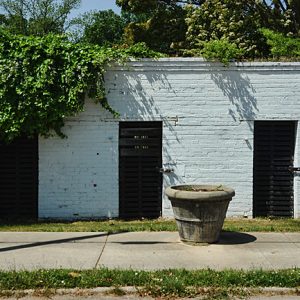calsfoundation@cals.org
McGehee City Jail
Constructed in 1908, the McGehee City Jail served the citizens of the Desha County town for less than three decades but played an important role in the settlement of the area. The structure was added to the National Register of Historic Places on January 21, 2011.
Benjamin McGehee and his family moved to the area in 1857, and his son Abner purchased 240 acres of land in 1876. With the establishment of the Little Rock, Mississippi River and Texas Railroad in 1878, McGehee opened a commissary along the route, which also passed through his land. The following year, a post office was established at the site and led to a steady increase in the local population. The town of McGehee (Desha County) incorporated in 1906.
The newly established city government worked to create services. Sources claim that the area around the town was infested by criminals who came out of the swamps to attack citizens before disappearing back to their hideouts. This led to the push for a town jail.
The town purchased a lot from Abner McGehee for $250, and work quickly commenced on the jail building. Total building costs were $536 for the three-cell building. The east-facing building is located on the southwest corner of the intersection of Pine Street and South First Street.
The brick building rests on a brick foundation and is topped with a concrete roof. Each cell includes a metal door that opens directly onto the sidewalk along First Street. The doors are constructed of metal strips, with about twenty horizontal and three vertical in each door. The doors include a handle and lock that bends around the door frame.
The sides of the building are unadorned brick, and the entire building is painted white. The rear of the building includes a small window for each cell. There is no glass in the windows or doors. The interior of the cells is quite sparse, and only the southernmost cell includes a toilet. The building sustained damage over time, with bricks missing from a cornice located at the top of the structure, but the building is in excellent condition overall.
Most of the criminals held in the jail were arrested for petty offences, including public drunkenness, disturbing the peace, and fighting. Domestic violence led to the incarceration of some local citizens, while robbery brought some inmates to the facility before they could be transferred to other jails. It was rare for people charged or suspected of a serious crime to be held for more than a short period in the jail. At least one escape was successful, with Sam Copeland breaking out of the facility on December 30, 1926.
During the Great Depression, a new combined city hall and jail was constructed, with the new facility opening in 1936. While no longer in use, the old jail continues to be an important reminder of the development of McGehee.
For additional information:
“McGehee City Jail.” National Register of Historic Places registration form. On file at Arkansas Historic Preservation Program, Little Rock, Arkansas. Online https://www.arkansasheritage.com/docs/default-source/national-registry/de0284-pdf.pdf?sfvrsn=8a220a8e_0 (accessed November 20, 2024).
David Sesser
Southeastern Louisiana University
 Early Twentieth Century, 1901 through 1940
Early Twentieth Century, 1901 through 1940 Historic Preservation
Historic Preservation Old McGehee City Jail
Old McGehee City Jail 



Comments
No comments on this entry yet.